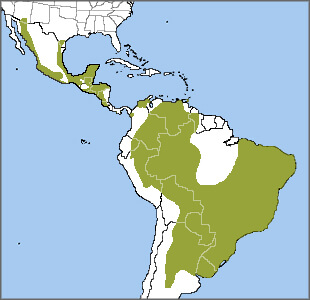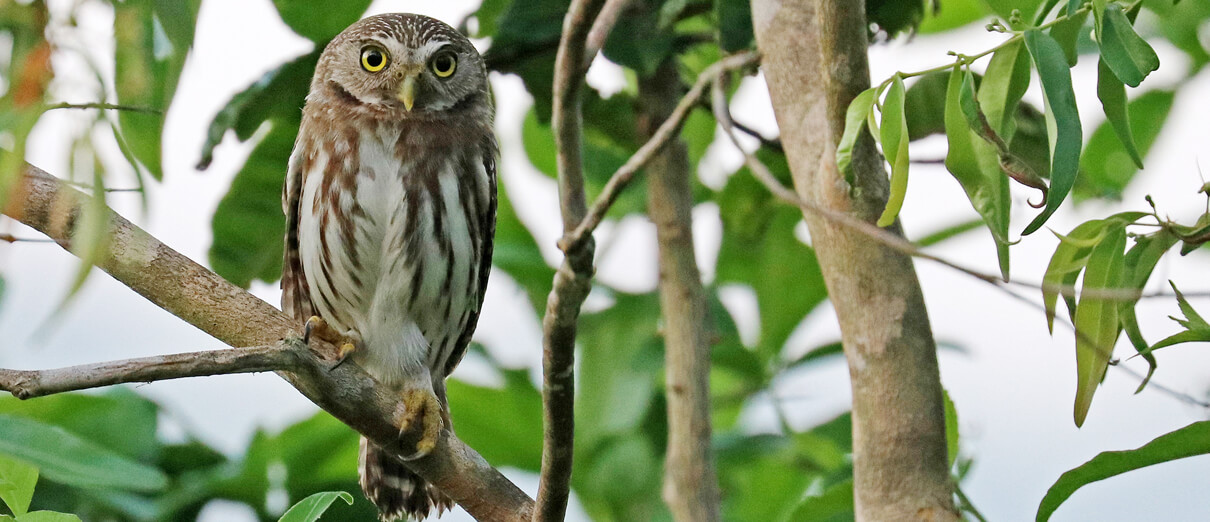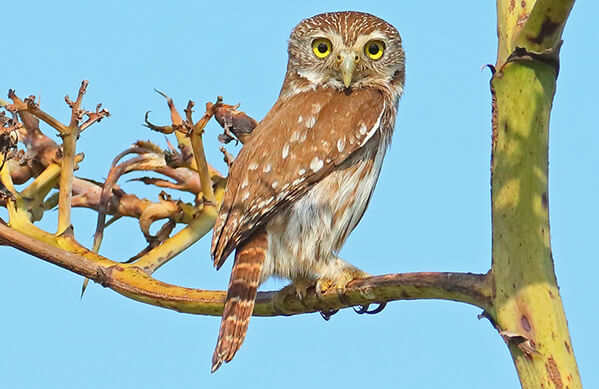
Ferruginous Pygmy-Owl map by ABC
At six inches tall, the Ferruginous Pygmy-Owl is only about the size of an Eastern Bluebird. But this stocky little owl is a formidable predator, with outsized feet and talons that allow it to attack prey up to twice its size. It's named for rusty-colored plumage on its long, barred tail. When agitated, the Ferruginous Pygmy-Owl cocks its tail up and down and swings it from side to side.
Like other pygmy-owls, the Ferruginous Pygmy-Owl lacks ear tufts and is active throughout the day, a habit it also shares with the Northern Hawk-Owl. One especially interesting plumage feature helps protect the Ferruginous Pygmy-Owl (and other pygmy-owls) from other birds — both potential predators and prey.
The Eyes Have It
The Ferruginous Pygmy-Owl has a distinctive pair of dark patches bordered with white on the back of its head. These dark spots, called "ocelli," resemble eyes. They are thought to help redirect attacks of predators such as Cooper's or Harris's Hawks, as well as mobbing by groups of smaller birds (potential prey) that harass this little owl throughout the day. The Ferruginous Pygmy-Owl's "eyes" may also confuse smaller birds, making them easier to capture if they perceive the owl is looking elsewhere.
Other small daytime raptors that may prey upon birds, such as the American Kestrel, also have ocelli, for the same reasons.
Wide-ranging Whistler
The Ferruginous Pygmy-Owl is the most numerous and widely distributed pygmy-owl species, found from the southwestern United States through Central and South America. It makes its home in a variety of lowland habitats, ranging from deserts to rainforests.
This small owl has a complicated taxonomy, which is still developing as more information is gathered. Up to 15 subspecies of Ferruginous Pygmy-Owl are currently recognized, some of which may eventually be recognized as full species. There are gray, brown, and red morphs, with many intermediate plumages.
Ferruginous Pygmy-Owls call during the day, but are most vocal around sunrise and sunset. Their main call is a staccato series of hollow-sounding whistles. This call is easily imitated by birdwatchers, who often use it to attract smaller birds.
Listen here:
(Audio: Peter Boesman, XC693542. Accessible at www.xeno-canto.org/693542)
Small but Deadly
Although small, the Ferruginous Pygmy-Owl is a ferocious and opportunistic predator. Its varied diet primarily consists of large insects, but also can include birds as large as doves and small quail, small mammals, and lizards.
Like the Snowy Owl, the Ferruginous Pygmy-Owl hunts during crepuscular and daylight hours, scanning for prey from a perch, then darting out in a quick strike when it sights its quarry. It also raids nest cavities for other species' nestlings. Interestingly, unlike many of its kin, this owl's ears are located symmetrically, suggesting that the Ferruginous Pygmy-Owl hunts by sight rather than sound. "Typical" nocturnal owl species, such as the Great Horned Owl and Northern Saw-whet Owl, have asymmetrical ear openings that allow them to zero in on prey in the dark.
Faithful Mates
The Ferruginous Pygmy-Owl forms monogamous, long-term pair bonds. The male defends a territory throughout the year, and both male and female reinforce their bond with mutual calling, preening, and food exchanges. Females are larger than males; otherwise, the sexes look alike.

Ferruginous Pygmy-Owl. Photo by David Fisher
Like parrots, trogons, and many other birds, the Ferruginous Pygmy-Owl is a cavity nester. Pairs typically choose an old woodpecker cavity in a tree or cactus; they will also use nest boxes, sometimes close to human activity. The same nest cavity may be re-used in successive years. In South America, Ferruginous Pygmy-Owls have been observed inhabiting even more diverse nest locations, including a hole in a termite mound and oven-shaped mud nests previously used by the Rufous Hornero, a mostly tropical species that is Argentina's national bird.
The female incubates her brood of three to five eggs alone. Both adults provide food for nestlings, which fledge after about a month. The adults continue to care for the young for several months after they leave the nest cavity.
Prickly Situation for Some Owls
Although the Ferruginous Pygmy-Owl is one of the most common owls in Central and South America, some populations are in trouble. One subspecies, the "Cactus" Ferruginous Pygmy-Owl of Arizona, has declined steeply and was listed as Endangered between 1997 and 2006. The U.S. Fish and Wildlife Service is proposing to list it once more as Threatened. (A decision is expected in 2023.) This bird faces combined threats of habitat loss and degradation, as well as further impacts wrought by climate change.
Although not considered globally threatened, other Ferruginous Pygmy-Owl populations are vulnerable to habitat loss and degradation. In South America, this species is sometimes kept as a cage bird, thought to bring good luck and success in love.
ABC's BirdScapes approach to conservation guides conservation and restoration of key habitats for the Ferruginous Pygmy-Owl, including riparian woods, mesquite thickets, and Saguaro desert. Rio Grande Joint Venture and Sonoran Joint Venture partners, including the U.S. Fish and Wildlife Service, also protect habitat for the "Cactus" subspecies.
Donate to support ABC's conservation mission!



















































